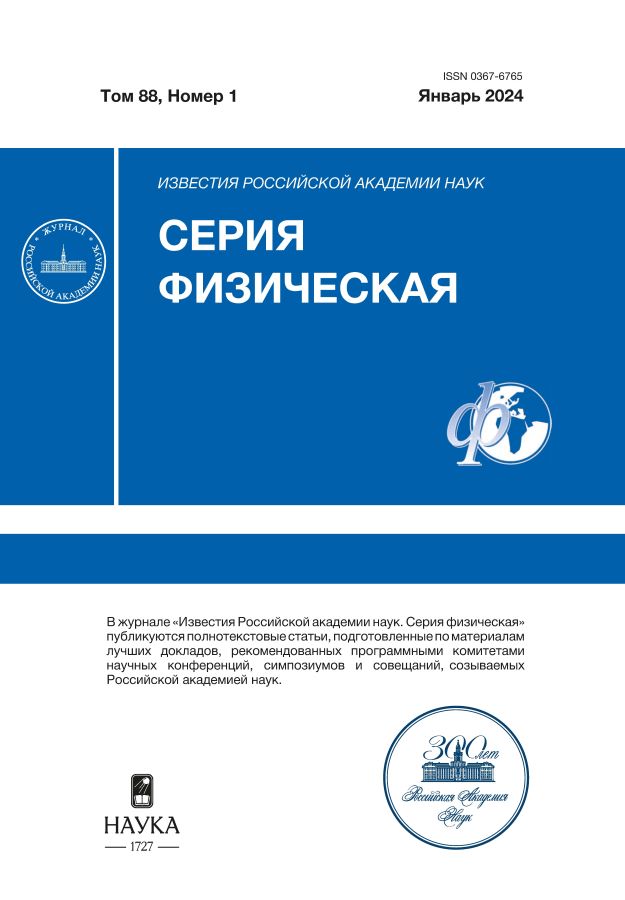Impact of treatment trajectory on the thermal ablation rate and biological tissue volumetric lesion during irradiation by shock-wave focusing ultrasonic beam
- Authors: Pestova P.A.1, Yuldashev P.V.1, Khokhlova V.A.1, Karzova M.M.1
-
Affiliations:
- Moscow State University
- Issue: Vol 88, No 1 (2024)
- Pages: 125-130
- Section: Wave Phenomena: Physics and Applications
- URL: https://jdigitaldiagnostics.com/0367-6765/article/view/654796
- DOI: https://doi.org/10.31857/S0367676524010225
- EDN: https://elibrary.ru/RZJYQU
- ID: 654796
Cite item
Abstract
Thermal ablation rates and the shapes of volumetric biological tissue lesion are compared in a numerical experiment, in which biological tissue is exposed to pulsed periodic shock-wave high intensity focused ultrasound. The comparison is performed across three different irradiation sequences of discrete foci placed uniformly within the target area.
Full Text
About the authors
P. A. Pestova
Moscow State University
Author for correspondence.
Email: pestova.pa16@physics.msu.ru
Physics Faculty
Russian Federation, MoscowP. V. Yuldashev
Moscow State University
Email: pestova.pa16@physics.msu.ru
Physics Faculty
Russian Federation, MoscowV. A. Khokhlova
Moscow State University
Email: pestova.pa16@physics.msu.ru
Physics Faculty
Russian Federation, MoscowM. M. Karzova
Moscow State University
Email: pestova.pa16@physics.msu.ru
Physics Faculty
Russian Federation, MoscowReferences
- Хилл К.Р., Бэмбер Дж., тер Хаар Г. Ультразвук в медицине. Физические основы применения. Пер. с англ. М.: Физматлит, 2008. 544 с.
- Гаврилов Л.Р. Фокусированный ультразвук высокой интенсивности в медицине. М.: Фазис, 2013.
- Köhler M.O., Mougenot C., Quesson B. et al. // Med. Physics. 2009. V. 36. No. 8. P. 3521.
- Kim Y.S., Keserci B., Partanen A. et al. // Eur. J. Radiol. 2012. V. 81. No. 11. P. 3652.
- Mougenot C., Köhler M.O., Enholm J. et al. // Med. Physics. 2011. V. 38. P. 272.
- Mougenot C., Salomir R., Palussière J. et al. // Magn. Reson. Med. 2004. V. 52. P. 1005.
- Enholm J.K., Köhler M.O., Quesson B. et al. // IEEE Trans. Biomed. Eng. 2010. V. 57. No. 1. P. 103.
- Андрияхинa Ю.С., Карзова М.М., Юлдашев П.В., Хохлова В.А. // Акуст. журн. 2019. Т. 65. № 2. С. 1; Andriyakhina Y.S., Karzova M.M., Yuldashev P.V., Khokhlova V.A. // Acoust. Phys. 2019. V. 65. No. 2. P. 141.
- Филоненко E.А., Хохлова В.А. // Акуст. журн. 2001. Т. 47. № 4. С. 541; Filonenko E.A., Khokhlova V.A. // Acoust. Phys. 2001. V. 47. No. 4. P. 541.
- Пестова П.А., Карзова М.М., Юлдашев П.В. и др. // Акуст. журн. 2021. Т. 67. № 3. С. 250; Pestova P.P., Karzova M.M., Yuldashev P.V. et al. // Acoust. Phys. 2021. V. 67. No. 3. P. 250.
- Пестова П.А., Карзова М.М., Юлдашев П.В., Хохлова В.А. // Сб. тр. XXXIV сессии РАО. (Москва, 2022). С. 927.
- Kreider W., Yuldashev P.V., Sapozhnikov O.A. et al. // IEEE Trans. Ultrason. Ferroelectr. Freq. Control. 2013. V. 60. No. 8. P. 1683.
- Karzova M.M., Kreider W., Partanen A. et al. // IEEE Trans. Ultrason. Ferroelectr. Freq. Control. 2023. V. 70. No. 6. P. 521.
- Карзова М.М., Аверьянов М.В., Сапожников О.А., Хохлова В.А. // Акуст. журн. 2012. Т. 58. № 1. С. 93; Karzova M.M., Averiyanov M.V., Sapozhnikov O.A., Khokhlova V.A. // Acoust. Phys. 2012. V. 58. No. 1. P. 81.
- Canney M.S., Khokhlova V.A., Bessonova O.V. et al. // Ultrasound Med. Biol. 2009. V. 36. No. 2. P. 250.
- Khokhlova T.D., Canney M.S., Khokhlova V.A. et al. // J. Acoust. Soc. Amer. 2011. V. 130. No. 5. P. 3498.
- Rosnitskiy P.B., Yuldashev P.V., Sapozhnikov O.A. et al. // IEEE Trans. Ultrason. Ferroelect. Freq. Contr. 2017. V. 64. No. 2. P. 374.
- Maxwell A.D., Yuldashev P.V., Kreider W. et al. // IEEE Trans. Ultrason. Ferroelectr. Freq. Control. 2017. V. 64. No. 10. P. 1542.
- Юлдашев П.В., Хохлова В.А. // Акуст. журн. 2011. Т. 57. № 3. С. 337; Yuldashev P.V., Khokhlova V.A. // Acoust. Phys. 2011. V. 57. No. 3. P. 333.
- https://itis.swiss/virtual-population/tissue-properties/database/acoustic-properties.
- Sapareto S.A., Dewey W.C. // Int. J. Radiat. Oncol. Biol. Phys. 1984. V. 10. No. 6. P. 787.
Supplementary files














